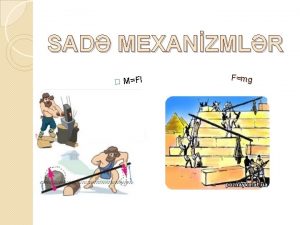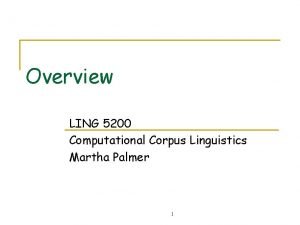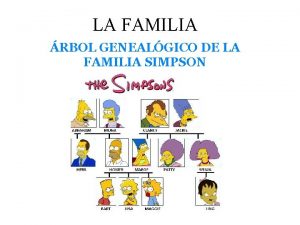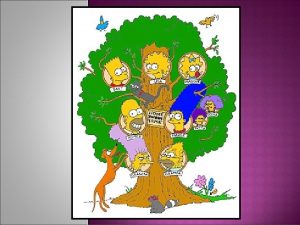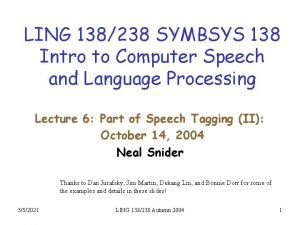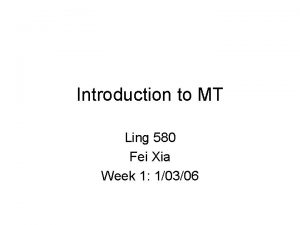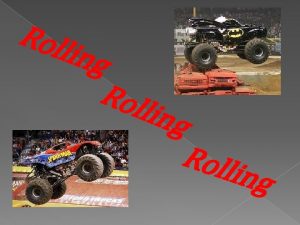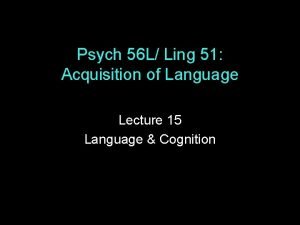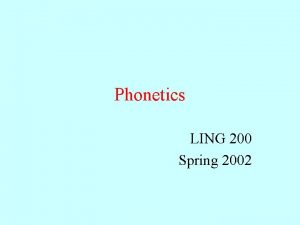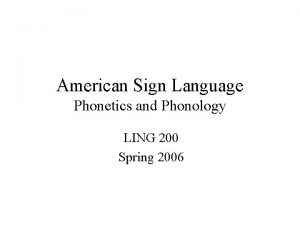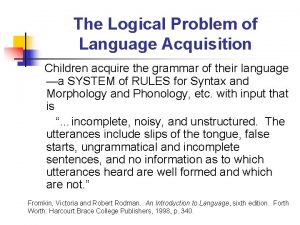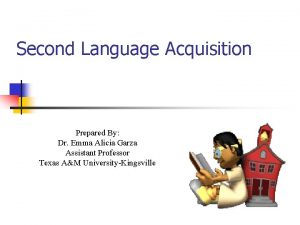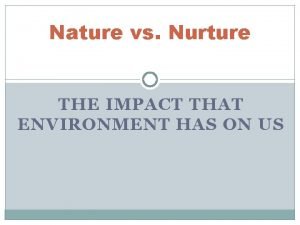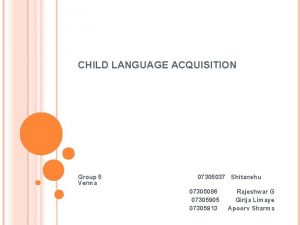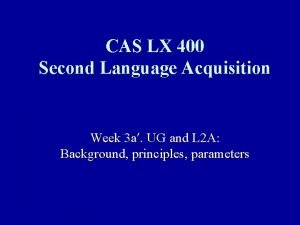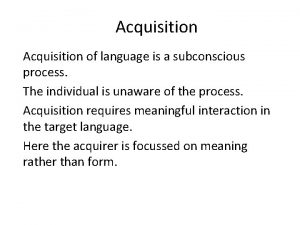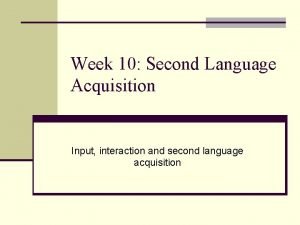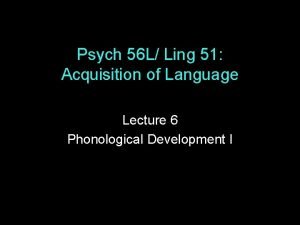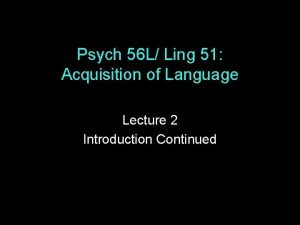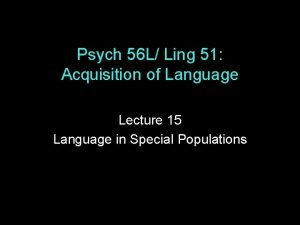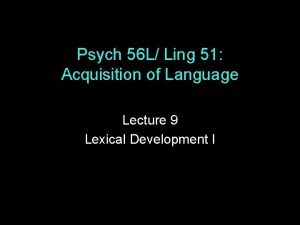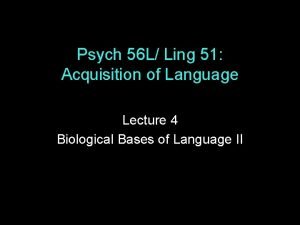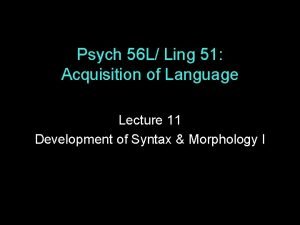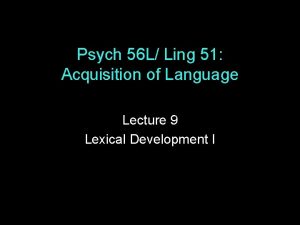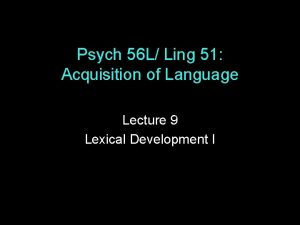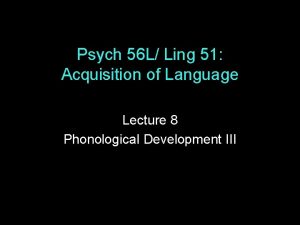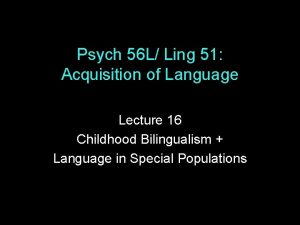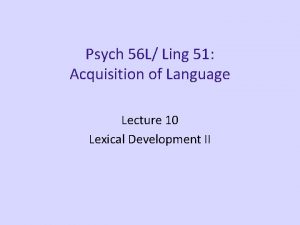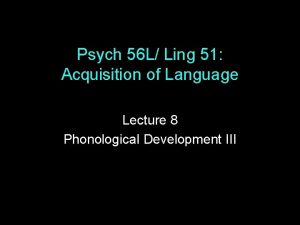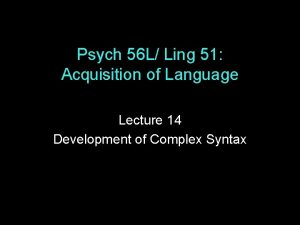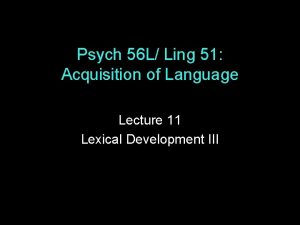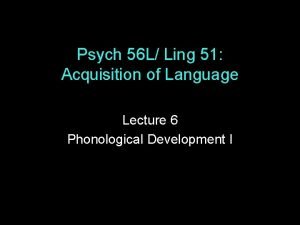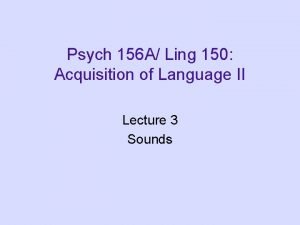Psych 56 L Ling 51 Acquisition of Language


















































![Common Phonological Processes in Child Speech Consonant cluster reduction: cracker [kr. Qk´r] --> kak Common Phonological Processes in Child Speech Consonant cluster reduction: cracker [kr. Qk´r] --> kak](https://slidetodoc.com/presentation_image/62b6ea140636debb1ae6147dd7618b92/image-51.jpg)




- Slides: 55

Psych 56 L/ Ling 51: Acquisition of Language Lecture 7 Phonological Development II

Announcements IPA sound chart available on the class webpage (can use for midterm and homework) Homework 1 due today, by the end of class Mistake from last lecture: The IPA for the English “r” sound is written ® (not r) Additional information not included in last lecture: The IPA for the English flapping consonant sound (heard in “water” and “butter”) is written R

Prelinguistic “Speech” Production

Stages of Prespeech Vocal Development Newborns make biologically-related sounds: reflexive crying, burping, breathing, sucking Helpful: infants’ vocal cords vibrate & airflow through the vocal apparatus is stopped and started

Stages of Prespeech Vocal Development Around 6 -8 weeks: infants start cooing (sounds that result from being happy). First coos sound like one long vowel - but over many months, they acquire a variety of different vowel sounds.

Stages of Prespeech Vocal Development Around 16 -30 weeks: vocal play. Infants use a variety of different consonant-like and vowel-like sounds. At the end of this stage, infants form long combinations of the sounds (marginal babbling). Recognizable vowel sounds heard at the beginning, while recognizable consonant sounds (usually velars like k/g) are usually heard around 2 -3 months. Recognizable consonant sounds occurring near the front of the mouth (n/m/p/b/d) come in around 6 months of age.

Stages of Prespeech Vocal Development Around 6 -9 months: canonical/reduplicated babbling, with actual syllables in the sounds produced (ex: [dadada]). These syllables are often repeated in a row. Social aspect: babies don’t give any indication that they’re babbling to communicate. They babble in the car and their crib, showing no sign that they expect any reply. Note: even deaf infants babble, but they tend to produce marginal babbling instead of canonical babbling.

Stages of Prespeech Vocal Development After canonical babbling: nonreduplicated/variegated babbling, with non-repetitive syllables and more variety in consonant and vowel sounds. Infants also incorporate prosody (the rhythm of the language) into their babbling, which makes it sound much more like they’re trying to talk. However, the “words” in this kind of babbling are usually only 1 or 2 syllables.

Stages of Prespeech Vocal Development 0 weeks reflexive crying, biological-based sounds 4 weeks cooing 16 weeks vocal play begins 36 weeks reduplicated/canonical babbling 48 weeks nonreduplicated babbling First Word

Is all babbling the same? Besides the differences between the vocal babbling of deaf children and non-deaf children, babies’ babbling is also influenced by the language they hear. How do we know? (1) Test competent native speakers. Record the babbling of babies who are learning to speak different languages (ex: French, Arabic, Chinese). See if native speakers can identify which baby’s babble is from their language (ex: asking French mothers to choose between Arabic babble and French babble as French. ) De Boysson-Bardies, Sagart, and Durand (1984): recordings of 8 -month-olds can be recognized by language.

Is all babbling the same? Besides the differences between the vocal babbling of deaf children and non-deaf children, babies’ babbling is also influences by the language they hear. How do we know? (2) See if babbling features accord with language features Determine which vowels and consonants appear in babbling, and how frequently they appear. Compare to target language’s vowels and consonants. (Can be subtle, though. ) Ex: Japanese & French words contain more nasal sounds than Swedish and English words; Japanese & Swedish babbles contain more nasal sounds than Swedish & English babbles.

Processes underlying speech sound development Three main factors Physical growth & development of the vocal tract Development of brain & other neurological structures responsible for vocalization Experience

Processes underlying speech sound development Physical growth & development of the vocal tract A newborn’s vocal tract is smaller & shaped differently from an adult’s. (Ex: The tongue fills the entire mouth, limiting range of motion. ) As the facial skeleton grows, the tongue gets more room. This happens during the vocal play stage, and the exploration of this new vocal freedom may be the cause of the vocal play itself.

Processes underlying speech sound development Development of brain & other neurological structures responsible for vocalization Later neurological developments in higher brain structures correlate with developments in vocalization. Ex: Onset of cooing at 6 -8 weeks coincides with development of limbic system (associated with expression of emotion in both humans and other animals). Maturation of areas in the motor cortex may be required for the onset of canonical babbling.

Processes underlying speech sound development Experience 1: Hearing the speech adults produce (influences the sounds children choose to babble and prosodic character of later babbling) Experience 2: Hearing their own vocal output (allows for calibration - matching what they produce to what they hear). Absence of auditory feedback may explain why deaf infants produce less elaborate vocal play than hearing infants, and reach the canonical babbling stage later.

Prelinguistic Speech Perception

Infants’ Hearing Infants’ hearing is not quite as sensitive as adults’ - but they can hear quite well and remember what they hear. Ex: Fetuses 38 weeks old A loudspeaker was placed 10 cm away from the mother’s abdomen. The heart rate of the fetus went up in response to hearing a recording of the mother’s voice, as compared to hearing a recording of a stranger’s voice.

Infants’ Hearing Infants’ hearing is not quite as sensitive as adults’ - but they can hear quite well and remember what they hear. Ex: newborns Pregnant women read a passage out loud every day for the last 6 weeks of their pregnancy. Their newborns showed a preference for that passage over other passages read by their mothers.

Studying Infant Speech Perception Researchers use indirect measurement techniques. High Amplitude Sucking (HAS) Infants are awake and in a quietly alert state. They are placed in a comfortable reclined chair and offered a sterilized pacifier that is connected to a pressure transducer and a computer via a piece of rubber tubing. Once the infant has begun sucking, the computer measures the infant’s average sucking amplitude (strength of the sucks).

Studying Infant Speech Perception Researchers use indirect measurement techniques. High Amplitude Sucking (HAS) A sound is presented to the infant every time a strong or “high amplitude” suck occurs. Infants quickly learn that their sucking controls the sounds, and they will suck more strongly and more often to hear sounds they like the most. The sucking rate can also be measured to see if an infant notices when new sounds are played.

Studying Infant Speech Perception Researchers use indirect measurement techniques. High Amplitude Sucking (HAS) Test Condition 1 Test Condition 2 Control (baseline)

Studying Infant Speech Perception Researchers use indirect measurement techniques. High Amplitude Sucking (HAS) Test Condition 1 Difference when compared to baseline Test Condition 2 Control (baseline)

Studying Infant Speech Perception Researchers use indirect measurement techniques. High Amplitude Sucking (HAS) Test Condition 1 Test Condition 2 No difference Control (baseline)

Studying Infant Speech Perception Researchers use indirect measurement techniques. Head Turn Preference Procedure Infant sits on caretaker’s lap. The wall in front of the infant has a green light mounted in the center of it. The walls on the sides of the infant have red lights mounted in the center of them, and there are speakers hidden behind the red lights.

Studying Infant Speech Perception Researchers use indirect measurement techniques. Head Turn Preference Procedure Sounds are played from the two speakers mounted at eye -level to the left and right of the infant. The sounds start when the infant looks towards the blinking side light, and end when the infant looks away for more than two seconds.

Studying Infant Speech Perception Researchers use indirect measurement techniques. Head Turn Preference Procedure Thus, the infant essentially controls how long he or she hears the sounds. Differential preference for one type of sound over the other is used as evidence that infants can detect a difference between the types of sounds.

Studying Infant Speech Perception Researchers use indirect measurement techniques. Head-Turn Technique Babies tend to be interested in moving toys. Using the presentation of a moving toy as a reward, babies are trained to turn their heads when they hear a change in the sound being presented.

Studying Infant Speech Perception Researchers use indirect measurement techniques. Head-Turn Technique A sound is played over and over, and then the sound is changed followed immediately by the presentation of the moving toy. After several trials, babies turn their heads when the sounds change even before the moving toy is activated.

Categorical Perception One feature of infants’ speech perception: categorical perception. Categorical perception occurs when a range of stimuli that differ continuously are perceived as belonging to only a few categories with no degrees of difference. Actual stimuli Perception of stimuli

Categorical Perception Adult categorical perception: Voice Onset Time (VOT) 60 ms

Categorical Perception Adult categorical perception: Voice Onset Time (VOT) % of responses as either [ta] or [da] [ta] [da] Voice onset time in msec

Categorical Perception Adult categorical perception: Voice Onset Time (VOT) Decision between da/ta Time to make decision

Categorical Perception Adult categorical perception: Voice Onset Time (VOT) Within-category discrimination is hard, across-category discrimination is easy D 0 ms 20 ms D D 20 ms 40 ms T T 40 ms 60 ms T

Categorical Perception Infant categorical perception: Voice Onset Time (VOT) Eimas et al. 1971: HAS technique across within control category (baseline)

Categorical Perception Infant categorical perception: Voice Onset Time (VOT) Eimas et al. 1971: HAS technique across within control category (baseline) Infants notice, compared to control

Categorical Perception Infant categorical perception: Voice Onset Time (VOT) Eimas et al. 1971: HAS technique across within control category (baseline) Infants don’t notice, compared to control

Categorical Perception Categorical perception: a special human ability? Categorical perception is not specific to the human ear, though - it’s a feature shared with other mammals like chinchillas!

Infant-directed speech

The nature of infant-directed speech Motherese/infant-directed speech/child-directed speech Intonational contour is greatly exaggerated: - higher-pitched voice, wider range of pitches, longer pauses, shorter phrases, slower tempo (vowels are prolonged) Motherese could be helpful for language learning: likely to highlight important features of speech, and provide more prototypical examples of a language’s speech sounds

How motherese helps Greater discriminability of phonemes (contrasting sounds in a language) in child-directed speech may help children establish phonemic categories (that signal meaning contrasts) Support: Mothers who produce more discriminable vowels in their infant-directed speech have infants who demonstrate better speech perception skills in laboratory tests.

How motherese helps…adults? Golinkoff & Alioto 1995: adults learned words in a foreign language better if the words were presented in infant-directed rather than adultdirected speech

Why babies like motherese Children like the exaggerated pitch contours the most? Fernald & Kuhl (1987): 4 -month olds prefer to hear infantdirected speech over adult-directed speech when all but the melody has been filtered out of it However, this may be due to positive interactions with their caretakers, as 1 -month olds actually only prefer childdirected speech when the entire speech signal is present.

Prosodic Bootstrapping Idea: Infants find important clues to language structure in the prosodic characteristics of the speech signal Support: 7 - to 10 -month-old children can identify clause boundaries in child-directed speech but not adult-directed speech “Over there is the castle beyond the goblin city, and I need to get there real quick…. ” clause boundary

But not motherese for everyone… While motherese may be very useful, it can’t be required for language acquisition since not all cultures use it. Some cultures (ex: Samoans, Papua New Guineans, Mayans, US African Americans in the rural south) do not address speech to prelinguistic children at all - so those children must learn some other way.

Phonological Development Once Speech Begins

Word Learning Even though infants can distinguish different sounds in their language (and ignore non-native sounds) by about 8 months, they seem to run into trouble when they try to distinguish words. Werker et al. 2002: 14 -month olds can’t tell the difference between “bih” and “dih” when they’re learning them as words - despite being able to hear the difference between /b/ and /d/ What’s the big deal? Sounds: no meaning attached Words: sound + meaning/reference in the world (harder!)

Word Production First words: simple syllable structure, often single syllables or reduplicated syllables (baba, dada). Usually the sounds that appear in the noncanonical babbling stage. Phonological idioms: words the child produces in a very adultlike way while still incorrectly producing other words that use the very same sounds. Demonstrate that children don’t really understand that words are broken down into sounds (phonemes), and are just producing some words as unanalyzed chunks (like idioms). Ex: “ball” [correct: ball, [bal]] vs. “wi’w” [correct: little, [l. IR´l]]

Phonological Process Development 18 months: children have developed systematic ways to alter the target language so it fits the sounds they’re able to produce (baby accent). These systematic transformations are called phonological processes. Some processes apply to a large portion of the word: “bottle” [ba. R´l] --> “baba” [baba] Other processes apply to individual segments: “church” --> “turch” (first affricate becomes a stop) “school” --> “kool” (consonant cluster deletion) ‘ball” --> “ba” (final consonant deletion)

Phonological Process Development Often, more than one process will apply to a word - which makes the original word harder to decipher. /bu/ = ? ? (referent in world = poop) /pup/ ---> delete final consonant = /pu/ ---> voice initial consonant = /bu/

Common Phonological Processes in Child Speech Whole-word: Weak syllable deletion: omission of unstressed syllable: ba. NAna --> NAna, BUtter. FLY --> BUFLY Final consonant deletion: because [bikaz] --> pika [pika] Reduplication: production of two identical syllables based on one syllable in the word: bottle [ba. R´l] --> baba Consonant harmony: one sound taking on features of another sound in the word: duck --> guk (point of articulation: velar)
![Common Phonological Processes in Child Speech Consonant cluster reduction cracker kr Qkr kak Common Phonological Processes in Child Speech Consonant cluster reduction: cracker [kr. Qk´r] --> kak](https://slidetodoc.com/presentation_image/62b6ea140636debb1ae6147dd7618b92/image-51.jpg)
Common Phonological Processes in Child Speech Consonant cluster reduction: cracker [kr. Qk´r] --> kak [k. Qk] Segment substitution processes Velar fronting: velar replaced by alveolar or dental: key [ki] --> ti Stopping: fricative replaced by a stop: sea [si] --> ti Gliding: liquid (r/l) is replaced by a glide (w/j): rabbit [r. Qb. It] --> wabbit [w. Qb. It], Lissa --> Yissa [j. Is´]

Why do they make these errors? Idea: Just a motor limitation. They can’t physically produce it all fast enough, but they can perceive the differences. Child: “Gimme my guk!” Father: “You mean your duck? ” Child: “Yes, my guk!” Father (hands child the duck): “Okay, here’s your guk. ” Child (annoyed): “No, Daddy - I say it that way, not you. ”

Why do they make these errors? Idea: Just a motor limitation. They can’t physically produce it all fast enough, but they can perceive the differences. But some contrasts are actually difficult for them to distinguish, such as /T/ from /f/ and /r/ from /w/. Production errors for these may have a basis in perception - their speech sound representation isn’t quite right yet. The jury is still out on the interaction between speech perception and speech production…

Recap: Sounds & Words are sequences of sounds, in particular the phonemes of the language. In order to learn words (both to comprehend and to produce them), children have to acquire a phonological representation for the words. And then they have to coordinate the motor actions required to produce the combinations of features. Given children’s incomplete development and lesser experience with the words of the language, they often make mistakes producing even words they’re familiar with. However, they make systematic mistakes, reflecting the underlying system they have for representing sounds.

Questions?
 Acquisition vs learning examples
Acquisition vs learning examples Language
Language Belief perseverance
Belief perseverance Jin ling cigarettes
Jin ling cigarettes Tərpənən tərpənməz blok
Tərpənən tərpənməz blok Ling
Ling Erin ling
Erin ling Ling oa
Ling oa Mei-ling from singapore was preparing
Mei-ling from singapore was preparing Arbol genealogico de la familia simpson
Arbol genealogico de la familia simpson Dr ng li ling
Dr ng li ling Nien-ling wacker
Nien-ling wacker Ling shih fu
Ling shih fu Ling simpson
Ling simpson Graph4ai
Graph4ai History of physical education in sweden
History of physical education in sweden Walter ling
Walter ling Ling
Ling Ling
Ling Ling
Ling Mt ling
Mt ling Wai ling lam
Wai ling lam Ling oa
Ling oa Wang ling relationship
Wang ling relationship Huo lingyu
Huo lingyu Ling roll
Ling roll Right marginal artery
Right marginal artery Language
Language Cheung yin ling
Cheung yin ling Wai ling lam
Wai ling lam Tree in ling
Tree in ling Short term goals
Short term goals Mei-ling huang
Mei-ling huang Ling 200
Ling 200 Ling internet
Ling internet Agnes ling
Agnes ling Ling 100
Ling 100 Ida ling
Ida ling Sign language phonetics
Sign language phonetics Logical problem of language acquisition
Logical problem of language acquisition Innate theory of language acquisition
Innate theory of language acquisition Language
Language Theories of 2nd language acquisition
Theories of 2nd language acquisition Similarities of vygotsky's piaget's and chomsky's theories
Similarities of vygotsky's piaget's and chomsky's theories Oxana malaya language acquisition
Oxana malaya language acquisition Nativization theory of second language acquisition
Nativization theory of second language acquisition Wida eld standards
Wida eld standards Four theories of language development
Four theories of language development Sequences of development
Sequences of development Compare and contrast first and second language acquisition
Compare and contrast first and second language acquisition Berko and brown fish
Berko and brown fish What is language acquisition device
What is language acquisition device Language
Language Language acquisition device
Language acquisition device A subconscious process in developing a language
A subconscious process in developing a language Language
Language




